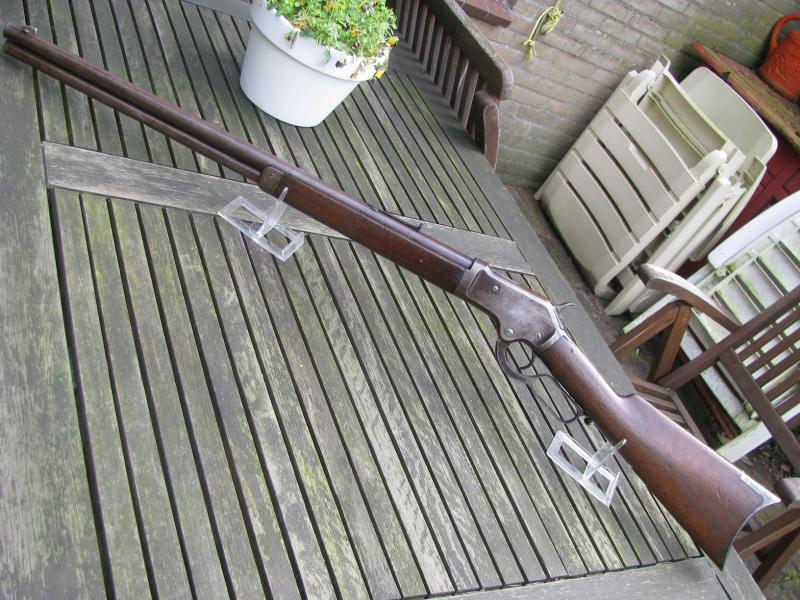Colt Burgess

(Colt Burgess. only 1.219 made with round barrel)
The Colt Burgess
A ONE-TIMER was the Colt-Burgess. In production for a little more than a single year, it was Colt’s sole
venture into the competitive production of lever-action rifles that began in the 1880s.
Product of the fertile design genius of Andrew Burgess, that prolific firearms inventor from Owego, New-
York, the rifle that Colt referred-to as their new magazine rifle had its beginning in 1882, when the big manu-
facturer of skguns engaged Burgess to design a lever-action rifle for them.
Evidently, Burgess lost no time in going to work on the project, profiting from his experience with the earlier
Whitney-Burgess design to develop and patent a stronger action that could be put into production as early as Juli 9, 1883 the date that the first Colt-Burgess rifle was manufactured.

Although the action was actuated by a linkage arrangement between lever and breechbolt, this time, Burgess used a solid link incorporating such an increase in action strength as to render it far stronger than its most popular competitor, the Model1873 Winchester. Like that famous rifle, the Colt-Burgess was chambered for the .44Winchester cartridge, which was later to be dubbed the .44-40. Unlike the Winchester, however, that was the only cartridge for which it was offered.
Obviously, the intent was to provide a companion rifle taking the same ammunition as the Colt Frontier single-actionrevolver. Buyers were given the choice Of a rifle with a twenty-five-inch octagon, half-octagon. or round barrel. Least popular was’ the half-octagon. Longer barrels could be ordered for an additional charge of one dollar per inch. The over-all length of the rifle was 42-3/4 inches. Carbines weighed 7-1/4 8-1/2 pounds; and octagon-barrel rifles weighed 8-3/4 Pounds.
The tubilar magazines were all fulllength to the muzzle. The 1883 Colt fullcatalog
listed the “number Of shots” as twelve for the carbine and fifteen for the rifle- The catalog is quoted verbatim here because it is not clear to me whether those numbers refer to magazine capacity alone or include a cartridge in the chamber.
All the rifles were fitted with curved rifle-style butt plates, and tRe carbines had the typical reversecurve carbine
butt. Steel plates were used on both types.
In his book The Rifle in America, Phil Sharpe stated that there was no record of a Colt-Burgess rifle having
been produced with a pistol-grip stock,but as my photograph shows, there was at least one such rifle made. To set the record straight, note also that the correct length of the rifle barrel was twenty-five inches rather than twentyfour, a fact borne out by the old Colt catalog.
Most Colt-Burgess rifles and carbines were plain sporting arms without checkering or other embellishment.
However, the rifle in the Photograph has finely executed checkering on a good grade of walnut, and the
photograph of a ColtiBurgess rifle in Haven and Belden’s book A History of the Colt Revolver shows an
exceptionally handsome stock with somewhat unusual checkeringpattern, as well as an engraved receiver, attesting to the fact that some of these rifles were produced in fancy grades.
The standard finish combined acolor case-hardened receiver, lever, and hammer with the barrel either
blued or browned, as was the tubular magazine. The sights were the usual pairing of a german-silver blade in
front and a leaf with a notched elevator set in a barrel dovetail in the rear.
Prices listed in the 1883 catalog were twenty-five dollars for the carbine, twenty-seven for a plain sporting rifle with a round barrel, and twenty-nine for a rifle with either an octagon or a half-octagon barrel.
rifles and carbines were produced, with approximately six out of ten being rifles. About two thirds of the rifles were made with octagon barrels.
The Colt-Burgess was discontinued in November, 1884, after a mere sixteen
months in production. Story has it that Winchester, fearing the competition that this superior rifle would pose for their weaker-actioned Model 1873, sought to induce Colt to give up the manufacturing of leveraction rifles. Winchester had plans to produce a revolver, and knowledge of these plans may well have been the motivation for Colt’s decision to drop the Burgess rifle.

(Winchester 1873 2nd model and Colt Burgess)
Whether this is a fact or merely a happenstance, I can’t say. Colt engineers were already working on the design for their “Lightning” slideaction rifle, and there may have been a decision to concentrate on it rather than to have two types of rifles.
Almost a hundred years later, all this is sheer conjecture. The facts aren’t known.
Colt-Burgess rifles are splendid pieces for collectors and should be preserved as such. This does not mean that they shouldn’t be fired. Factoryloaded .44-40 cartridges are purposely loaded to low pressures and velocities and would be perfectly safe in one of these rifles in good, sound condition.
But no high-speed handload should beused! And if such a rifle is fired, it should be cleaned well before it is put
away. It is not use but rather abuse that destroys the value of a collectorgrade firearm. A total of only 6,403 Colt-Burgess were made.
http://www.riflemagazine.com/magazine/PDF/ri81partial.pdf

Maak jouw eigen website met JouwWeb